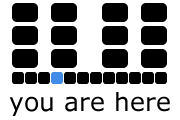Archive
by Jentery, Curtis, Matthew & Jamie
Given that this multi-authored investigation of the contexts and practices of social tagging began with a group analysis of the Library of Congress (LoC) Flickr Commons digital photo collection, it is no wonder that questions of archiving, categorization, and navigation would begin to emerge as common concerns across our various responses. And given that the primary impulse of the Commons Project is to open up the LoC, Smithsonian, and New York Public Library’s analog photo archives (amongst others) to public comment, annotation, and folksonomic tagging, it is natural that our responses have jointly struggled to elaborate the effects of social tagging upon a massive archive of this type. What kind of archive is produced in what Matt calls “the flat, categorical” and “non-hierarchical” space of the folksonomy? Submitting this question to our various analyses produces a number of answers.
Curtis approaches this question directly, arguing decisively that tags contributed to the Common’s various photo artifacts each “consolidate the archive in idiosyncratic ways.” “Tagging,” in instances such as these does not so much “describe” digital artifacts as much as it appropriates them and composes them in the name of more general logics of history and identity.
Arguing that metadata plays a functional role in defining the relation between the object in question and the archives it is a part of through its basic categorical impulse, Curtis insists that we understand instances of metadata as arguments that each “differently constitute the photo as a historical object, variously conditioning what kind of knowledge it can be.” In a collection of artifacts like the one offered by the Library of Congress, whose archival impulse is clearly historical, metadata constitutes a series of arguments about what particular histories are relevant, what is most relevant to those histories, and how those histories are to organized and understood. In this sense, as Matt comments, “categories and comments make the archive.” And, as Jentery notes, the sheer volume of different and overlapping archives that are “made” in this way “don’t make sense or add up.” They are rife with contradictions and excesses, as well as the potential for, as Curtis puts it, different categorical principles that can “reorganize collective experience and the cultural archive in the name of different stories and identities.” Most generally, the archive that metadata produces here is multiplicitous, contradictory, and ultimately contingent, creating opportunities for intervention and analysis at the level of the archive’s foundational, organizational logics.
An entirely different stance on metadata emerges out of a focus on navigation. Noting that “SITM [Standards in the Making] frames metadata as a mechanism” which operates by “influencing situational knowledge production without necessarily determining it,” Jentery argues that emergent metadata standards also construct “interoperable” archives which allow users to process massive volumes of data to potentially surprising results. Because they constitute standards that are always being made, tags aggregate data objects in unpredictable ways which facilitate “a kind of “stumbling upon” new materials” which can also “spark new research into associations or relationships often overlooked when archives are assembled around more familiar schemas.” Instead of working across the relatively discrete archives constructed by the “readymade” standards offered by disciplinary conventions and historical norms, SITM archives suggest both connections to other archives and new research questions at their intersection. Here, the multiple and overlapping archives that metadata produces offers opportunities whose value is, at least in part, due to the potential for “serendipity when dealing with a large volume of texts and information” across numerous linked archives aggregated around multiple, overlapping standards.
Whether one chooses to broach the question of metadata through construction or navigation, what is clear is that SITM produces archives whose form and function is anything but business as usual for those who choose to engage them on whatever level. Exactly what how we will make use of these archives is a question for the new work of composing.
